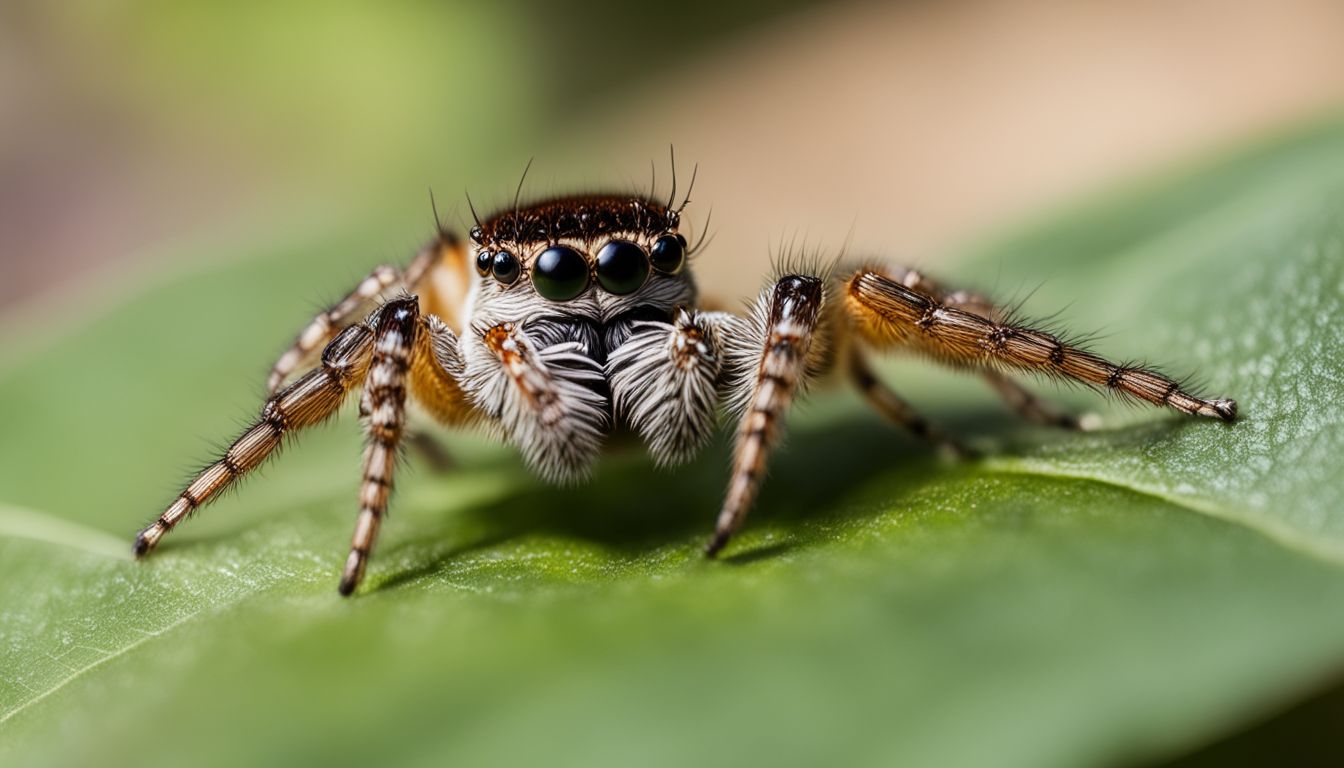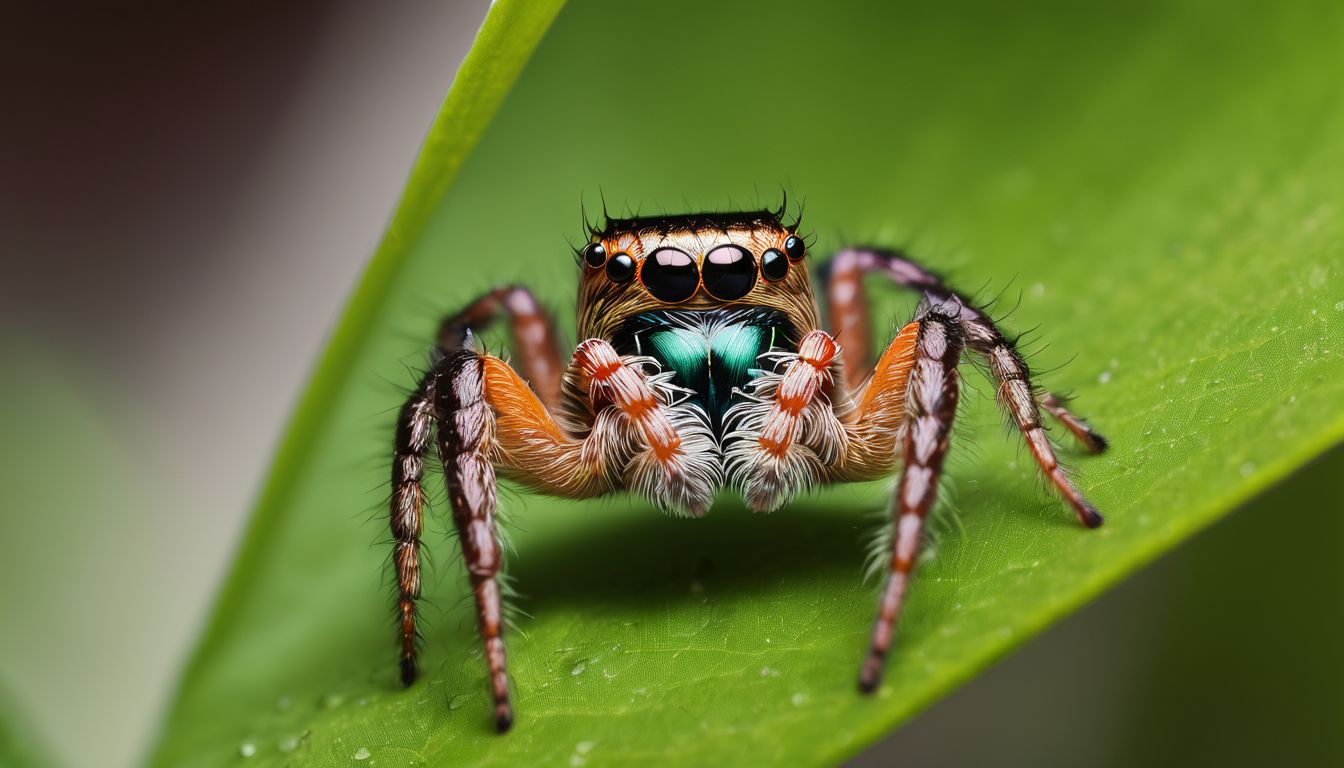Are you curious about what those lively little jumping spiders munch on? Jumping spiders, known for their impressive leaps, are expert hunters that feast primarily on a variety of insects.
Whether you’re a spider enthusiast or just starting to learn, our article breaks down the fascinating diet of these arachnids and offers valuable insights for anyone caring for a pet jumper.
Dive in to discover the menu of a jumping spider – it’s more intriguing than you might expect!
Key Takeaways
- Jumping spiders are skilled hunters that primarily feast on small insects like flies, moths, crickets, beetles, and occasionally nectar.
- They use their sharp vision to spot prey from afar and rely on quick reflexes and agility to capture their food without spinning webs.
- When caring for a pet jumping spider, it’s crucial to provide suitable live prey such as crickets or flies 2-3 times per week and ensure a balanced diet by offering a variety of feeder insects.
Understanding the Jumping Spider’s Predatory Nature

Jumping spiders are skilled hunters, using their keen vision and quick reflexes to capture their prey. They primarily feed on small insects and are known for their agility and stealth in stalking and ambushing their food.
How Jumping Spiders Hunt Their Prey
Jumping spiders are skilled hunters. They catch food without spinning webs.
- Eyes play a big part. These spiders have great vision which helps them spot prey from afar.
- Quick legs help them pounce. When they see something to eat, they leap swiftly to grab it.
- Spiders sneak up quietly. They move close without making noise before they jump.
- They use smarts, too. Jumping spiders must think and plan to catch other smart bugs or even spiders.
- Patience is key for hunting. They wait for the right moment to attack their dinner.
The Role of Vision in Capturing Food
Jumping spiders have amazing eyesight. They use their sharp vision to spot food and make sure it’s good to eat. Their big front eyes let them see colors well and notice tiny details in the world around them.
This helps them hunt better than most other spiders.
Spiders in the Salticidae family, which includes these little jumpers, watch for small movements that tell them where their next meal might be hiding. When they see something move, they get ready to pounce with great care.
They can even tell mates from enemies thanks to their clear sight.
Next up is a look at what kinds of bugs jumping spiders like to munch on!
The Varied Menu of a Jumping Spider

Jumping spiders have a diverse diet that includes common insects like house flies, fruit flies, and beetles. They also occasionally consume nectar for plant-based nutrition.
Common Insects in the Jumping Spider Diet
Jumping spiders are great hunters. They eat many kinds of bugs.
- Flies: These spiders catch lots of flies. They use their quick jumps to grab them right out of the air.
- Moths: Small moths are perfect for jumping spiders. At night, they sneak up and pounce on these winged snacks.
- Crickets: These hopping insects become meals too. The spiders stalk crickets quietly before leaping.
- Other Spiders: Jumping spiders will also hunt smaller spiders. They show no mercy to their eight-legged cousins.
- Mealworms: Soft and easy to catch, mealworms make a tasty treat for these predators.
- Beetles: Spiders often go after beetles, using their speed and surprise attacks.
- Wasp Larvae: When they can find them, wasp larvae are a nutritious choice for a spider’s diet.
Occasional Plant-Based Nutrition: Nectar Intake
As we’ve seen, jumping spiders primarily prey on insects like flies, beetles, and caterpillars. However, it’s interesting to note that these tiny predators are not strictly carnivorous.
Research has shown that jumping spiders also supplement their diet with occasional plant-based nutrition. They have been observed consuming nectar and plant sap as alternative food sources.
Spiders are known for deriving nutrients from vegetarian sources such as fluids like nectar; adding variety to their diet and promoting a balanced intake of essential nutrients. This behavior showcases the flexibility of these fascinating arachnids in obtaining sustenance from diverse food sources beyond just insects.
Feeding a Pet Jumping Spider
When it comes to feeding a pet jumping spider, it’s important to provide suitable live prey such as fly larvae or wax worms. Understanding the frequency and amount of feeding, as well as tips for ensuring a balanced diet, is crucial for the health and wellbeing of your pet jumping spider.
Suitable Live Prey for Captivity
Jumping spiders in captivity thrive on a diet of small insects, providing essential nutrients and protein. Here are some suitable live prey options for feeding your pet jumping spider:
- Crickets: A staple food for captive jumping spiders, providing good nutrition and exercise.
- Mealworms: Rich in protein and easy to store, making them an excellent food choice.
- Wax worms: High in fat and calcium, these are great as occasional treats for your spider.
- Fruit flies: Easy to maintain and a suitable option for feeding juvenile or smaller spiders.
- Flies, moths, and beetles: These insects can be fed occasionally to provide variety in the spider’s diet.
Frequency and Amount of Feeding
When it comes to feeding your pet jumping spider, it’s important to ensure they are fed 2-3 times per week. Due to their high metabolic rate, these little hunters need frequent meals.
Young jumping spiders should be fed more often than adults because they are still growing and developing.
Young jumping spiders should ideally be fed every 2-3 days while adult ones can be fed less frequently due to their relatively lower energy requirements. Keep an eye on the amount of food they consume and adjust the feeding schedule accordingly.
Tips for Ensuring a Balanced Diet
To make sure your jumping spider gets a balanced diet, follow these tips:
- Provide a variety of feeder insects like crickets, flies, roaches, mealworms, and moths to offer diverse nutrition.
- Ensure the feeder insects are healthy and well – fed as they provide essential nutrients to the jumping spider.
- Rotate the types of insects you feed your spider to maintain a diverse and healthier diet.
- Keep an eye on your spider’s eating habits to ensure it is consuming an adequate amount of food for its well-being.
The Influence of Light on Jumping Spider Hunting Habits
Jumping spiders have excellent vision and can see ultraviolet light, blues, and greens. This influences their hunting habits as they use their keen eyesight to track and pounce on prey.
In fact, firefly flashing can deter some predators while attracting jumping spiders, affecting their prey choice due to the spider’s ability to perceive this light phenomenon. This significant relationship between light and the hunting habits of jumping spiders showcases how crucial visual perception is in their predatory behavior.
Understanding the impact of light on jumping spider hunting habits helps us appreciate how these tiny creatures rely on vision to capture food effectively. Their unique ability to perceive various wavelengths of light plays a vital role in shaping their predatory behavior.
6. Special Considerations for Juvenile Spiders.
Special Considerations for Juvenile Spiders
What to Feed Baby Jumping Spiders and How to Ensure Their Nutritional Needs are Met. Read on to learn more about caring for juvenile spiders!
What to Feed Baby Jumping Spiders
Baby jumping spiders have specific dietary needs, including high protein and essential nutrients. When selecting food for baby jumping spiders, consider the following options:
- Fruit flies or pinhead crickets: These small prey items are suitable for feeding baby jumping spiders due to their size and nutritional value.
- Spider milk: Some baby jumping spiderlings depend entirely on nutritious spider milk, much like mammal babies nursing from their mothers.
- Small ants or aphids: These tiny insects can provide a suitable meal for baby jumping spiders.
- Drosophila melanogaster (common fruit fly): These flies are an excellent choice of live food for young jumping spiders due to their small size and high nutritional content.
- Micro crickets: These tiny crickets are ideal for feeding baby jumping spiders as they offer the necessary nutrients without being too large.
Conclusion
In conclusion, jumping spiders are carnivorous hunters that primarily eat insects like flies, moths, crickets, and beetles. Some species have been observed consuming nectar as well.
When keeping a pet jumping spider, it’s important to offer live prey such as crickets or flies to ensure their health and well-being. Understanding the dietary needs of jumping spiders is crucial for providing them with a balanced and suitable diet in both the wild and captivity.
To learn more about how light affects the hunting habits of jumping spiders and other arachnids, visit our informative article on “Are Spiders Attracted to Light?”.
FAQs
1. What do jumping spiders like to eat?
Jumping spiders enjoy eating small bugs such as waxworms, dubia roaches, and meal worms. They catch these by predating while being active during the day.
2. How do you feed a jumping spider?
You can give a jumping spider food with feeding tweezers. This helps you drop their prey right where they can jump and grab it.
3. Can I give my jumping spider sugar water?
Yes, some people offer their jumping spiders sugar water for extra energy since they’re always moving and hunting in daylight.
4. Are all jumping spiders meat-eaters?
Most of them are obligate carnivores which means they mainly eat other insects, but one kind called Bagheera kiplingi also eats plant stuff making it more like an omnivore.
5. Do jumping spiders eat the same things as big tarantulas?
No, while both are predators that like bugs, tarantulas can handle bigger prey compared to the smaller bugs that fit a jumping spider’s tiny mouth.




